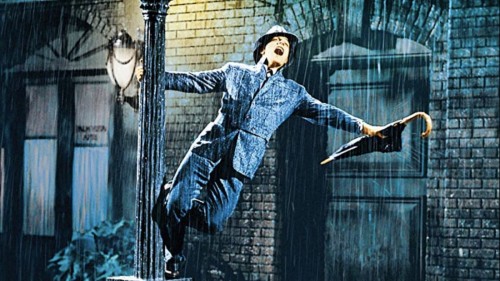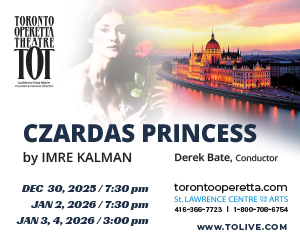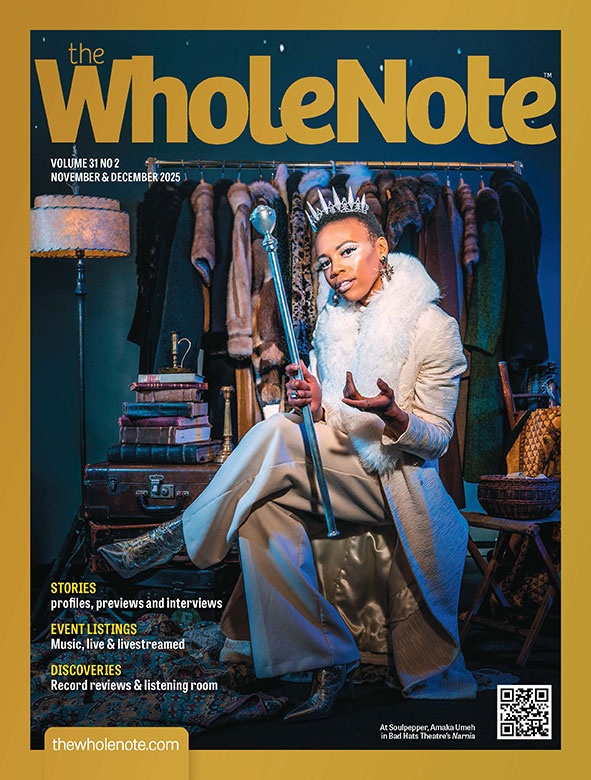Two pm this past February 8 was a Saturday afternoon, and my concert companion and I had barely had time to settle into our Roy Thomson Hall balcony seats with our beer and popcorn before the lights, already dim, dipped even more, and a fractional moment of quiet rippled across the cheerful din of the place, the way a passing cloud wiping the face of the sun high above a summer lake evokes a moment’s hush.
(You can always tell it’s February in Toronto when people like me distract themselves from a task at hand by starting to talk, out of nowhere, about the summer.)
Where was I? Ah yes. February 8, about four minutes past 2pm, in the balcony level of Toronto’s most imposing cultural hall of mirrors. The momentary hush that descended on the room when the lights flickered is turning into a ripple of applause as our conductor for the day, Jack Everly, strides briskly onto the stage.
If it’s less of a ripple of applause than one might reliably expect at that moment in the concert ritual, it’s certainly not because the crowd is smaller than usual – the place is, as far as I can tell from where I am sitting, pretty much its usual respectably crowded self. And it’s not because the audience is already settling morosely into an appropriate frame of mind for something portentous – there’s a palpable buzz and hum in the air. Mostly it’s less of a ripple than one might have expected, because the logistics of applause are complicated with a beer in one hand and popcorn in the other.
Toronto Symphony Orchestra members already seated on stage do their usual decorous bit to salute the maestro as he enters – they tap their bows carefully on their instruments; stamp their feet in a refined (and of course rhythmic) way; there are smiles all round.
Everly strides to the front of the stage, all affable business, picks up a microphone that just happens to be there, and invites us all to have a good time, cheer for our heroes if we feel like it, laugh or cry if we want to, and applaud or not as the mood strikes. And then, all business, he turns to the orchestra, all attention. The lights take a deeper dive, a deeper hush descends. He raises his baton … and the movie begins.
Calling it a “movie” in these splendid surrounds is, I readily concede, not the most formal way of addressing it. Film With Orchestra is how it’s titled on the cover of the TSO program book I picked up on my way out of the hall (I had a hand free by then).
Mind you, that’s not what it’s called inside the program. On subsequent closer inspection, on the page with the official production credits for the highly successful road show, it is styled A Symphonic Night at the Movies which neatly captures the middle-brow appeal of the thing: neither film as art nor “a flick at the bioscope,” as I would have called it as a nine-year-old child in 1962 (in another country) ten years after this particular movie was made.
Whatever one calls it, film with orchestra has become, for a whole bunch of reasons, a hybrid genre that is much in vogue. The TSO, for example, does four of them a year in its own season. Three of them, this season (two Star Wars movies and Home Alone, which has become a perennial Christmas holiday offering), are branded showcases for the astonishing film score output of composer John Williams. The fourth generally digs into film classics: last year it was, if I remember, Casablanca. Today it is 1952’s Singin’ In the Rain, starring Gene Kelly, Donald O’Connor and Debbie Reynolds.
 I understand the appeal. For movie fans it’s a chance to get under the hood of an aspect of movie-making normally hidden from view. For millions of people, for whom orchestral scores, consciously or unconsciously, are intrinsic to the way we are programmed daily as to what to feel and think, it’s a revelation to see how the all-too-familiar sounds are made: a bit like actually seeing milk come from a cow rather than from a carton on a shelf. I like to think there are favourable statistics out there concerning how many people who came primarily for the novelty value of seeing a favourite film in a new context discover the orchestra as something worth revisiting in its own right.
I understand the appeal. For movie fans it’s a chance to get under the hood of an aspect of movie-making normally hidden from view. For millions of people, for whom orchestral scores, consciously or unconsciously, are intrinsic to the way we are programmed daily as to what to feel and think, it’s a revelation to see how the all-too-familiar sounds are made: a bit like actually seeing milk come from a cow rather than from a carton on a shelf. I like to think there are favourable statistics out there concerning how many people who came primarily for the novelty value of seeing a favourite film in a new context discover the orchestra as something worth revisiting in its own right.
As for die-hard fans of the orchestra, it’s a chance to spend time in the hall, indulging a passion, without any of the usual self-appointed distractions of having to instruct less couth patrons in the etiquette of cultural palaces – a chance to let our hair down, so to speak.
So I was expecting to have fun, and would have, even without the popcorn and beer. What I wasn’t expecting was the way this particular film in this context has stayed with me for the past few weeks, taking on an aesthetic shape and colour: posing questions
(and suggesting answers) about the relationships we cannot afford to take for granted in regard to the continually evolving relationship between artists and audiences.
Part of the reason it was so interesting is the pivotal moment in the history of film that is at one and the same time the reason for the film’s existence and it’s own major storyline – the advent of the talking picture. Stars of the silent screen died off, metaphorically, in droves; new stars were born; actors who could actually act, singers who could actually sing, and dancers who could actually dance were suddenly able to bring prodigious live performance skills to a mass audience. Studios acquired orchestras where previously movie houses had theatre organs or player pianos. Sound stages on an immense scale came into existence.
Memorably, February 8 in the RTH balcony, I found the inner story of the film being played out all over again, in a crazed, Escher-like version of itself: as though the fun-house mirrored twists and turns of Roy Thomson Hall’s intentionally disorienting lobbies and levels had been transported into the auditorium itself.
There was one moment, for example, where I found myself watching the TSO live on the RTH stage (with a pull-down movie screen most of them could not see above their heads), making beautifully synchronized music for an orchestra on the screen, reduced once again to silent-movie puppetry by technology’s latest twist and turn; while, to top it all off, on that screen an auditorium of people sat watching their orchestra accompanying the same stars that our orchestra was. Layers within layers.
There was a more fundamental moment for me, though, well into the movie’s second half. (Yes, there was an intermission to top up on popcorn and beer.)
It came during one of the film’s memorable songs – not one of the obvious ones, like the title song, that had dozens of audience members happily singing along, but “Would You” a lovely gentle waltz, masterfully positioned at the film’s moment of denouement, ricochetting from bathos to pathos, in a lovely arc:
He holds her in his arms,
would you, would you?
He tells her of her charms,
would you, would you?
I suddenly became aware that the person seated next to me was singing, completely comfortably and absorbed entirely in the moment. Not “singing along,” just singing. Not an audience member “joining in.” Nor aware, even for an instant, that she herself had an audience. Just feeling permitted.
And here’s the point: she would not have had that permission either in a movie theatre or in a concert hall. It was a gifted moment, arising from a uniquely oddball set of circumstances: the live audience watching the live orchestra brought the people on the silver screen to life in a way that film alone cannot. The privacy of the typical film-watching experience kept other audience members at bay, in a way that the typical concert environment does not.
It’s an alchemy we all, artists and presenters alike, need to seek.
After all, if, as the bard says, “all the world’s a stage,” then what’s an audience?
Three days later: Tuesday February 11, at the COC
“Oh, it’s a starry night!” my opera companion, delighted, turns to me and says, very quietly, as the Hansel and Gretel overture starts and the mysterious-looking panelled stage curtain we have been eyeing for the past ten minutes or so, speculating as to how its panels will part and divide, reveals what is behind it. Like lightning the person in the row right in front of us spins around. Her “SSSSHHHHH!!!” can be heard at least 15 rows back. Our slightly sheepish discomfort lasts all of the three minutes it takes for the same individual to take things to the next level by whacking the elbow of the person next to them with a rolled up program, for encroaching over the midline of the seat arm.
Thirteen years ago, approximately
In the selfsame balcony at Roy Thomson Hall. It is a performance of Bach’s St. John Passion. One of it’s great chorales “O grosse Lieb” has just commenced and someone, I would guess in his 80s, deep in the moment and alone with the music starts, quietly, to do what Bach instructs – to sing along. Someone turns to chastise ...
David Perlman can be reached at publisher@thewholenote.com




